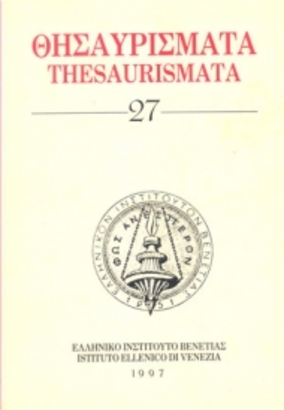Χώροι υποδοχής ταξιδιωτών και εμπορευμάτων στη βενετοκρατούμενη Πελοπόννησο
Part of : Θησαυρίσματα ; Vol.34, 2004, pages 395-407
Issue:
Pages:
395-407
Author:
Abstract:
During the first and second periods of Venetian domination of the Peloponnese (13th-16th cent, and 1685-1715) there exists evidence of the establishment of various reception areas for travellers and goods (hospices and hospitals, inns, taverns, warehouses and stores, quarantines stations). This paper attempts the collection of data on their function, their founders, the people who worked there and those who received their services. Through the study of the constituent evidence we reach the conclusion that the creation of the aforementioned areas served mainly the needs of the Venetian sea trade and the marine transport of the western powers in Eastern Mediterranean in general. In reciprocity, these specific needs influenced the formation of the physical planning of the peloponnesian towns, through the erection of buildings in specific, functional locations, and contributed to the economic development of the local population. Within the basically agricultural econom
y of the peloponnesian province during the post-byzantine period, the trade and travel service sector was one of the few effective factors in the largely ineffectual course towards the urban development of the Peloponnese.
Subject (LC):
Notes:
Περιέχει σημειώσεις, Η μελέτη, στην κεντρική ιδέα της, είχε παρουσιασθεί ως ανακοίνωση στο Η΄ Συμπόσιο Ιστορίας και Τέχνης: «Επικοινωνίες και ανταλλαγές στη Μεσόγειο και τη Μαύρη Θάλασσα μέσω Πελοπόννησον». Οργάνωση: Μονεμβασιώτικος Όμιλος, Κάστρο Μονεμβασίας, 21-23 Ιουλίου 1995, τα Πρακτικά του οποίου δεν έχουν δημοσιευθεί ακόμη, για λόγους ανεξάρτητους από τη θέληση της Οργανωτικής Επιτροπής του. Εδώ, δημοσιεύεται σε αναπτυγμένη μορφή, μετά από σχετική συνεννόηση με την Πρόεδρο του Μονεμβασιώτικου Ομίλου, κυρία Χάρι Καλλιγά., Μνημόσ
νο Μανούσου Μανούσακα




